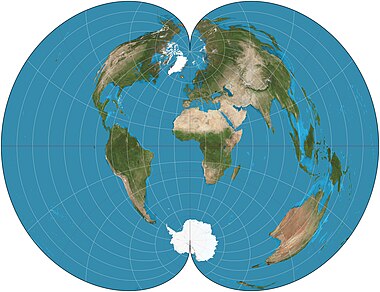Talk:Polyconic projection class
| This article is rated Stub-class on Wikipedia's content assessment scale. It is of interest to the following WikiProjects: | |||||||||||||||||
| |||||||||||||||||
Local maps
[edit]Projections for smaller regions are in preparation. mdf 15:17, 16 October 2006 (UTC)
Replace low-contrast images
[edit]
I will be replacing images on the various map projection pages. Presently many are on a satellite composite image from NASA that, while realistic, poorly demonstrates the projections because of dark color and low contrast. I have created a stylization of the same data with much brighter water areas and a light graticule to contrast. See the thumbnail of the example from another article. Some images on some pages are acceptable but differ stylistically from most articles; I will replace these also.
The images will be high resolution and antialiased, with 15° graticules for world projections, red, translucent equator, red tropics, and blue polar circles.
Please discuss agreement or objections over here (not this page). I intend to start these replacements on 13 August. Thank you. Strebe (talk) 22:46, 6 August 2011 (UTC)
File:American Polyconic projection.jpg to appear as POTD soon
[edit]Hello! This is a note to let the editors of this article know that File:American Polyconic projection.jpg will be appearing as picture of the day on July 8, 2016. You can view and edit the POTD blurb at Template:POTD/2016-07-08. If this article needs any attention or maintenance, it would be preferable if that could be done before its appearance on the Main Page. — Chris Woodrich (talk) 01:24, 23 June 2016 (UTC)
- Looks great, Chris Woodrich! Many thanks. Strebe (talk) 16:31, 23 June 2016 (UTC)
"Chinese polyconic projection"
[edit]I deleted a series of edits by User:146.96.252.3 that mention a "Chinese polyconic projection". The projection it notes does appear to have a history of use in China, but the Chinese article on the topic does not have good sources, let alone ones available to an English encyclopædia. This appears to be a situation where some common phenomenon that you would expect to be notable has no WP:NOTABLE sources. If anyone has good information about this projection, we should figure out how to proceed with something more responsible than a poorly-sourced Chinese article and a commercial map. Strebe (talk) 18:27, 15 July 2017 (UTC)
- Okay, I think I found a rigorous source for the projection in Section 12.4. This is encouraging. Strebe (talk) 18:33, 15 July 2017 (UTC)
- But, unfortunately, the formulæ are incompletely described (what is b? and C? What are and ? etc.) and idiosyncratic (why is x-axis vertical)?Strebe (talk) 19:15, 15 July 2017 (UTC)
- Okay, this appears to be the source. Strebe (talk) 19:28, 15 July 2017 (UTC)







